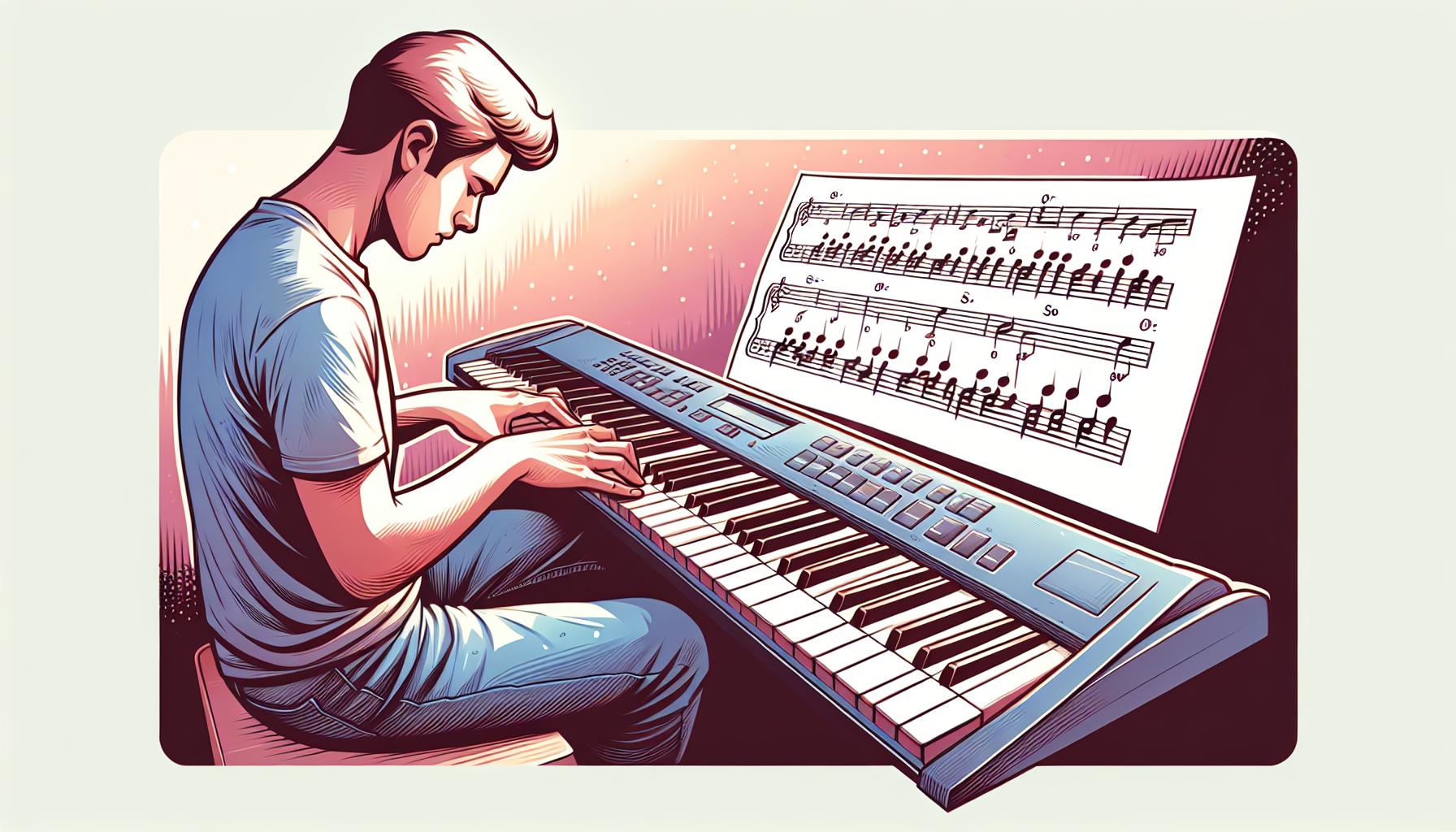Starting to learn the keyboard can feel like a daunting task, especially if you're eager to play your favorite pop songs. But guess what? There's a whole world of catchy, easy-to-learn tunes that are perfect for beginners. These songs not only sound great but also provide a solid foundation in keyboard basics, from chord progressions to melody lines.
Diving into pop songs is a fantastic way to stay motivated and enjoy your musical journey from the get-go. They're familiar, fun, and often come with simple structures that make them ideal for those just starting out. So, if you're ready to start tickling those ivories with some pop flair, you're in for a treat.
Understanding Chord Basics
Embarking on a musical journey, especially with the keyboard, involves a fundamental appreciation of chords and their role in creating harmony and melody. For beginners, grasping chord basics is not just about learning how to play; it's about unlocking the simplicity behind popular music.
Chords are essentially a group of notes played together to create a harmonious sound. What makes pop songs ideal for beginners is that they often rely on a limited set of simple chords, making them easier to learn and master. These chords—major, minor, and seventh chords—are the building blocks of countless songs and are your first step towards playing catchy tunes.
Major Chords: The Happy Sounds
Major chords are known for their bright and cheerful sound, fitting perfectly with the upbeat sections of pop songs. They're formed by combining the root note, the major third, and the perfect fifth of the major scale. For instance, a C major chord involves playing C, E, and G. These chords are often used in the chorus to lift the mood and create a memorable melody.
Minor Chords: The Soulful Echoes
In contrast, minor chords carry a more somber tone, adding depth and emotion to a song. They consist of the root note, the minor third, and the perfect fifth. Switching from an A major chord (A, C♯, and E) to an A minor chord (A, C, and E) lowers the third by a half step, drastically changing the vibe of the music. This tonal shift is essential in adding complexity and variety to the tunes.
Seventh Chords: A Touch of Jazz
Seventh chords add an extra layer of sophistication and are frequently found in pop music bridges or as part of a song's hook. They're built by adding a fourth note, the seventh, to the basic triad, creating an even richer sound. For example, a G seventh chord (G7) will include G, B, D, and F. These chords often introduce a sense of anticipation or a lead-in to a powerful section of the song.
- Learn the basic chord shapes for major, minor, and seventh chords on the keyboard.
- Practice transitioning between these chords smoothly, as pop songs often involve quick changes.
- Select easy pop songs that utilize a few simple chords and play along with the track
Simple Melodies to Practice

As beginners find their footing in the realm of keyboard playing, transitioning from mastering chords to incorporating melodies presents a thrilling next step. Simple melodies, often found in pop songs, offer an avenue through which novices can explore various aspects of music theory in practice. These tunes aren't just catchy; they're also considerably easy to pick up, even for someone just starting out.
One of the charms of pop music lies in its straightforward structure—usually a verse followed by a chorus that repeats. This repetition aids beginners in recognizing patterns and understanding song construction. Moreover, many pop songs utilize a limited range of notes, making them less daunting for those who are still familiarizing themselves with the keyboard layout.
Pop songs from the 80s and 90s, in particular, are known for their melodious and straightforward keyboard parts. Songs like "Every Breath You Take" by The Police or "Don't Stop Believin'" by Journey feature memorable keyboard riffs that are not overly complex. These classics provide an excellent starting point for beginners eager to combine chord progressions with melodic playing.
In addition to these older hits, contemporary tracks also serve as great learning material. Artists like Adele and Ed Sheeran often use simple but effective piano parts in their music, making their songs accessible for keyboard learners. Adele's "Someone Like You" and Sheeran's "Perfect" are prime examples of modern pop songs that combine simplicity with emotional depth, making them enjoyable yet straightforward pieces to learn.
To assist beginners in navigating their learning journey, here's a list of pop songs, categorized by their difficulty level, to practice:
-
Easy
- "Let It Be" by The Beatles
- "Clocks" by Coldplay
- "All of Me" by John Legend
- "Lean on Me" by Bill Withers
- "Imagine" by John Lennon
- "I'm Yours" by Jason Mraz
This approach of starting with simpler songs and gradually moving to more challenging pieces allows beginners to build confidence and skill incrementally. Furthermore, practicing these songs not only enhances technical ability but also helps in developing a keen ear for melody and harmony.
Building Finger Dexterity

As beginners dive into the world of pop keyboard songs, building finger dexterity becomes a crucial step in their musical journey. This progression from mastering chords to playing melodies isn't just about learning notes—it's about making those notes fluid, expressive, and ultimately, effortless. Finger strength and agility play a significant role in this process, enabling new players to transition smoothly between chords and melodies.
Practicing scales is an invaluable method for improving finger dexterity. Though it might seem monotonous, engaging in daily scale practice can significantly enhance one’s ability to maneuver across the keyboard with precision and speed. C Major, being a scale without sharps or flats, is an excellent starting point for beginners. As confidence and skill level increase, incorporating minor scales and those with sharps and flats adds complexity and further challenges finger coordination.
Hand independence is another critical area to focus on. Often, beginners find their hands want to mirror each other's movements. To combat this, exercises specifically designed to promote hand independence should be integrated into practice routines. Playing different rhythms or notes with each hand can initially be frustrating but becomes easier with perseverance. This skill not only boosts dexterity but also prepares players for the intricate melodies and harmonies found in many pop songs.
To put these skills into a practical context, beginners should start with simple pop songs that allow them to apply what they've learned. Songs with repetitive chord progressions or melodies are particularly useful. For instance, Adele's “Someone Like You” offers a repetitive, yet soulful, piano riff that’s perfect for practicing chord transitions and finger pacing. Similarly, Ed Sheeran’s “Perfect” stands as another example of a song with a gentle melody line that’s great for beginners to learn fluid hand movements.
Engaging in Effective Practice Techniques
To maximize the benefits of practice, beginners should adopt effective techniques that encourage progression. Setting small, achievable goals for each practice session can help maintain focus and motivation. Whether it's mastering a new scale, perfecting a section of a song, or improving hand coordination, having specific objectives can make practice sessions more productive.
Tips for Playing with Rhythm

When beginners venture into playing pop songs on the keyboard, mastering the rhythm is just as crucial as getting the notes right. Rhythm acts as the heartbeat of any song, setting the pace and bringing the music to life. For newcomers, grasping the rhythm might initially seem daunting, but with some focused strategies, it becomes an integral part of their musical journey.
First and foremost, listening is key. Before even attempting to play a song, beginners should immerse themselves in its rhythm by listening to it multiple times. This practice helps internalize the beat, making it easier to replicate when playing. Creating a mental map of the song’s structure can significantly improve one's ability to play with the correct rhythm.
Metronomes are invaluable tools for learners. These devices keep a consistent beat, aiding players in maintaining a steady tempo. Beginners should start practicing with a metronome at a slow pace, gradually increasing the speed as they become more comfortable with the song. Here's a simple progression strategy:
| Starting Tempo (BPM) | Increase After Mastery |
|---|---|
| 60 | 5-10 BPM |
| 70 | 5-10 BPM |
| 80 | When ready |
Tapping the rhythm with hands or feet before playing can also bridge the gap between understanding the rhythm and executing it on the keyboard. This physical manifestation of the beat helps solidify the timing and flow of the music.
Another tip is to break down the rhythm into smaller, more manageable components. Focusing on mastering the rhythm of one section at a time allows for a deeper understanding and more precise execution when combining them later.
Practicing hand coordination exercises separately can further enhance rhythmic accuracy. Since many pop songs require simultaneous melody and rhythm, developing independence between the hands ensures that the rhythm remains steady even as the melody varies. Simple exercises, such as playing different rhythms with each hand or alternating between them, can make a substantial difference.
Incorporating rhythm-centric exercises into practice routines is beneficial. Clapping rhythms, using rhythm flashcards, or even playing along with drum beats can heighten one’s rhythmic awareness and agility.
Lastly, patience and persistence are vital. Rhythm skills, like any aspect of musicianship, require time to develop. Celebrating small victories and incremental progress keeps motivation high and makes the learning process enjoyable.
Fun Pop Songs to Get Started

When embarking on the journey of learning pop songs on the keyboard, it's crucial for beginners to choose pieces that are not only popular but also straightforward and enjoyable to play. These songs often have simple chords and rhythms, making them perfect for new players. Here's a list of fun pop songs that are excellent for beginners to get started with.
- "Let It Be" by The Beatles: This classic song has a slow, clear melody and simple chord progressions.
- "All of Me" by John Legend: With its emotional depth and repetitive structure, it’s great for practicing chord transitions.
- "Clocks" by Coldplay: Featuring a distinctive piano riff, this song is fantastic for learning rhythmic patterns.
- "Lean on Me" by Bill Withers: This song offers a great lesson in playing chords and melody together.
These songs not only help in honing keyboard skills but also keep the learning process engaging and fun. Practicing them can boost confidence as beginners start to play recognizable tunes right from the start.
Advancing from mastering rhythm, incorporating these pop songs into practice sessions can provide a more comprehensive learning experience. They encourage students to apply their rhythmic skills in playing real music, bridging the gap between exercises and performance. Moreover, playing enjoyable and familiar tunes can significantly enhance motivation. It gives immediate feedback on progress, as improvements can be heard and felt directly through the music they're playing.
To effectively learn these songs, beginners should focus on breaking them down into smaller sections. It's often helpful to start with the chord progressions before adding the melody. Listening to the original track can serve as a great reference and inspiration. Many of these songs also have tutorials and sheet music available online, which can be invaluable resources for self-learners.
Incorporating technology into practice can also enhance the learning experience. Using apps and websites that offer interactive piano lessons and games can make practice sessions more engaging. These tools often have features that allow learners to play along with the song at a slower tempo, gradually increasing speed as they become more comfortable.
Practicing these pop songs can go beyond merely playing the right notes. Beginners should pay attention to the dynamics and expression of the music. Adding personal touches to their rendition of the song can make the performance unique and more enjoyable for both the player and the audience.
Conclusion
Diving into the world of pop songs on the keyboard opens a door to not only mastering a new instrument but also enjoying every step of the journey. By starting with catchy, easy-to-learn tunes, beginners can quickly feel a sense of accomplishment. It's about making practice sessions as enjoyable as they are educational. With the right approach, breaking songs down, and embracing technology, anyone can turn their practice into a captivating musical adventure. Remember, it's not just about hitting the right notes; it's about expressing yourself through music. So grab your keyboard, pick a song, and let your musical journey begin.
Harlan Kilstein began playing piano during covid with no piano background at all. He taught himself how to play learning what to do and what not to do.
Today he's an advanced intermediate player and can help you grow in your skills because he learned all this on his own.








